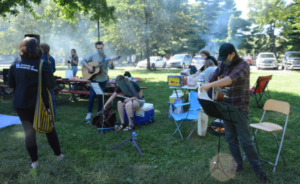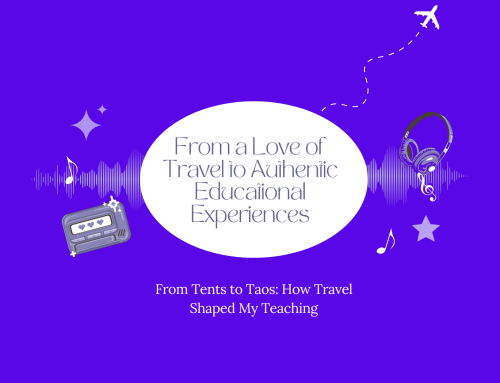Table of Contents
Silver Linings
I’m an optimist at heart, so some of you are going to hate the cheery tone of this post, particularly since there are a million difficulties and things to complain about right now as we do our best to teach music during a pandemic. But, here you have it. As a teacher to both preservice music teachers and children PreK–6, I have been surprised at some of the positives that have emerged from the past six months, both in the context of my profession and in my personal life.
1. Socially-Distanced Preschool Rocks
I don’t know how many of you preschool music teachers can commiserate, but for me, one of the hardest parts of teaching preschool was keeping their wriggly little bodies to themselves in circle time. This means not touching their neighbors and not wandering off to see what interesting thing is on the shelf behind them. Now, I come to preschool, and they are all at their own little desk. We move in our chairs, stand up and move in place, and I direct their locomotor movement around their tables. They are bright-eyed and bushy-tailed, and it’s been my favorite part of the week! Miracles do happen! I’m keeping this format even post-corona. Thanks, corona! (I never thought I’d be typing those words).
2. Outdoor Folk Dancing
This idea emerged from my brilliant college students as we were trying to figure out how to practice teaching for my general methods class. It seems obvious to go outside, but my main concern was having a sound system loud enough and finding the space where we’d be allowed to do it. Solution? A public park that also happens to have an outlet and a willing colleague with audio equipment (our university audio engineer, Aaron). Further, my students offered to get our university bluegrass band to play the music, and one student insisted on bringing his portable grille and making food for everyone. Since I use folk dances from The Shenanigans, which is not bluegrass music, I had my doubts that the group could have the music ready; I was thankful for Aaron the audio-man to be my back up. However, low and behold, the bluegrass band arrived, had all the music transcribed, and it sounded a-mazing.

Click here to hear a snippet of the band playing Flying Pieman from the Shenanigans, led by one of my students who wore his kilt! https://drive.google.com/file/d/1FVg_jiFXa3c27klAYBEXU-b24KVPvJS9/view?usp=sharing
My biggest worry for my methods class (giving them authentic contexts in which to teach) quickly dissolved. So, we held two Saturdays of folk dancing at the park (each 2 hours long) and invited a local church group to join (I worked with them since the spring semester). Parents brought their children (ages 6–16), we all masked up, and 15 of my college students got to practice their 15-minute folk dance lessons over the two days. Again, this is something I would like to continue even post-corona. Brilliant!
3. Working within Work Hours
This is probably the part where readers will hate me the most, but please understand that I’ve been a workaholic my entire life and developed terrible boundaries for myself, particularly during graduate school. In fact, I had no boundaries. Being slightly OCD, it manifested in continually checking my email and responding immediately (my inbox was always ten or fewer emails) and constantly working on homework and lesson plans. I had no social life; I didn’t want one. I wanted to finish my Ph.D. Now into my sixth year at the University of Kentucky, two things have happened that have pushed me to finally set boundaries and keep them. COVID-19 was one of them. Because of the pandemic, I became hyperaware of the need for downtime, to be away from screens, and to give other people space and grace. This came at the exact time I went up for tenure (submitted my dossier in June, whoo whoo!), so now I feel like I’m “allowed” to relax a little, at least for a semester. For the first time in more than a decade, I’ve had consecutive weekends where I didn’t do work. I actually stop working in the evenings and allow myself time to call people, take a walk, watch a show, or read a book. This more relaxed pace, I think, has not only had a positive effect on me (allowing me to stay healthy, both physically and mentally), but also the people with whom I work and my students. I hope never to go back to the way I used to communicate and organize my life. I’m actually living a life now.
These are my three main silver linings, and I wish each one of you the best as you navigate the strangest and (likely) toughest school year of your lives. I find that looking at the silver linings helps me to feel better, and perhaps it can do the same for you.




Leave A Comment